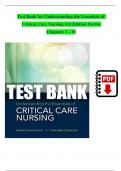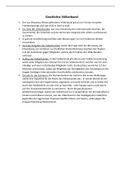Test Bank for Understanding the Essentials of
Critical Care Nursing 3rd Edition Perrin
Chapters 1 - 19
, TEST BANK FOR UNDERSTANDING THE ESSENTIALS OF CRITICAL CARE NURSING
3RD EDITION BY KATHLEEN PERRIN, CARRIE MACLEOD
TABLE OF CONTENT
1. What is Critical Care?
2. Care of the Critical Ill Patient
3. Care of the Patient with Respiratory Failure
4. Interpretation and Management of Basic Dysrhythmias
5. Cardiodynamics and Hemodynamic Regulation
6. Care of the Patient Experiencing Shock
7. Care of the Patient Experiencing Heart Failure
8. Care of the Patient Experiencing Acute Coronary Syndrome
9. Care of the Patient Following Traumatic Injury
10. Care of the Patient Experiencing an Intracranial Dysfunction
11. Care of the Patient With a Cerebral or Cerbrovascular Disorder
12. Care of the Critically Ill Patient Experiencing Alcohol Withdrawal and/or Liver Failure
13. Care of the Patient With an Acute Gastrointestinal Bleed or Pancreatitis
14. Care of the Patient with Problems in Glucose Metabolism
15. Care of the Patient with Acute Kidney Injury
16. Care of the Organ Donor and Transplant Recipient
17. Care of the Acutely Ill Burn Patient
18. Care of the Patient with Sepsis
19. Care of the ICU Patient at the End of Life
, Perrin: Understanding the Essentials of Critical Care
Chapter 1: What is Critical Care?
MULTIPLE CHOICE. Choose the one alternative that best completes the stateme
1) Of the following patients, who should be cared for in a critical care unit? A pati
apply.)
A) With an acetaminophen overdose
B) Suffering from acute mental illness
C) With chronic renal failure
D) With acute decompensated heart failure
ANSWER: A, D
Explanation: A) (Note: This requires multiple responses to be correct.)
Critical care units are c o- e
s tfficient units for caring for patients
system failure. Although the organ failing in #4 is obvious, pa
overdose often suffer liver failure as a consequence. #2 and #3
of a noncritical nature.
Nursing Process: Evaluation
Cognitive Level: Analysis
Category of Need: Physiological Integrity–Physiological Adapt
,B) (Note: This requires multiple responses to be correct.)
Critical care units are c o- e
s tfficient units for caring for patients
system failure. Although the organ failing in #4 is obvious, pa
overdose often suffer liver failure as a consequence. #2 and #
of a noncritical nature.
Nursing Process: Evaluation
Cognitive Level: Analysis
Category of Need: Physiological Integrity–Physiological Adapt
C) (Note: This requires multiple responses to be correct.)
Critical care units are c o- e
s tfficient units for caring for patients
system failure. Although the organ failing in #4 is obvious, pa
overdose often suffer liver failure as a consequence. #2 and #3
of a noncritical nature.
Nursing Process: Evaluation
Cognitive Level: Analysis
Category of Need: Physiological Integrity–Physiological Adapt
D) (Note: This requires multiple responses to be correct.)
Critical care units are c o- e
s tfficient units for caring for patients
system failure. Although the organ failing in #4 is obvious, pa
overdose often suffer liver failure as a consequence. #2 and #3
of a noncritical nature.
Nursing Process: Evaluation
Cognitive Level: Analysis
Category of Need: Physiological Integrity–Physiological Adapt
,2) A hospital in a small rural town would be able to provide which level of care in
A) Level I
B) Level II
C) Level III
D) It is unlikely that the hospital would have a critical care unit
ANSWER: C
Explanation: A) #1 and #2 describe more advanced and inclusive critical care
all because most hospitals have some critical care areas.
Nursing Process: Evaluation
Cognitive Level: Application
Category of Need: Safe, Effective Care Environment–Managem
B) #1 and #2 describe more advanced and inclusive critical care
all because most hospitals have some critical care areas.
Nursing Process: Evaluation
Cognitive Level: Application
Category of Need: Safe, Effective Care Environment–Managem
C) #1 and #2 describe more advanced and inclusive critical care
all because most hospitals have some critical care areas.
Nursing Process: Evaluation
Cognitive Level: Application
Category of Need: Safe, Effective Care Environment–Managem
D) #1 and #2 describe more advanced and inclusive critical care
all because most hospitals have some critical care areas.
Nursing Process: Evaluation
Cognitive Level: Application
Category of Need: Safe, Effective Care Environment–Managem
3) A nurse employed in an "open" ICU would most likely be working with a:
A) Multidisciplinary team with physicians who are also responsible for patien
B) Multidisciplinary team that includes a physician employed by the hospital.
C) Physician in charge of patient care who is a specialist in critical care.
D) Primary care physician who must consult a critical care specialist.
ANSWER: A
Explanation: A) #2, #3, and #4 refer to "closed" ICUs.
Nursing Process: Evaluation
Cognitive Level: Analysis
Category of Need: Safe, Effective Care Environment–Managem
B) #2, #3, and #4 refer to "closed" ICUs.
Nursing Process: Evaluation
Cognitive Level: Analysis
Category of Need: Safe, Effective Care Environment–Managem
C) #2, #3, and #4 refer to "closed" ICUs.
Nursing Process: Evaluation
Cognitive Level: Analysis
Category of Need: Safe, Effective Care Environment–Managem
D) #2, #3, and #4 refer to "closed" ICUs.
,4) According to the Institute of Medicine, technology increases the likelihood of e
when:
A) It relies heavily on human decisi-om
n aking.
B) Devices are programmed to function without do u- bc lhee c ks .
C) It makes the workload seem overwhelming to health care providers.
D) There is uniform equipment throughout each facility.
ANSWER: B
Explanation: A) #1, #3, and #4 have not been identified to increase the likelih
care unit.
Nursing Process: Evaluation
Cognitive Level: Comprehension
Category of Need: Safe, Effective Care Environment–Managem
B) #1, #3, and #4 have not been identified to increase the likelih
care unit.
Nursing Process: Evaluation
Cognitive Level: Comprehension
Category of Need: Safe, Effective Care Environment–Managem
C) #1, #3, and #4 have not been identified to increase the likelih
care unit.
Nursing Process: Evaluation
Cognitive Level: Comprehension
Category of Need: Safe, Effective Care Environment–Managem
D) #1, #3, and #4 have not been identified to increase the likelih
care unit.
Nursing Process: Evaluation
Cognitive Level: Comprehension
Category of Need: Safe, Effective Care Environment–Managem
,5) Which of the following is a common example of installing forcing functions or s
order to prevent errors?
A) Prior to administration of insulin, two nurses check the dose.
B) Prior to obtaining a medication, height, weight and allergies are recorded.
C) All medications are checked by two nurses prior to administration.
D) Undiluted potassium chloride is not available on critical care units.
ANSWER: D
Explanation: A) #1 and #3 are examples of avoiding reliance on vigilance; #2
constraints.
Nursing Process: Evaluation
Cognitive Level: Application
Category of Need: Physiological Integrity–Pharmacological an
B) #1 and #3 are examples of avoiding reliance on vigilance; #2 i
constraints.
Nursing Process: Evaluation
Cognitive Level: Application
Category of Need: Physiological Integrity–Pharmacological an
C) #1 and #3 are examples of avoiding reliance on vigilance; #2 i
constraints.
Nursing Process: Evaluation
Cognitive Level: Application
Category of Need: Physiological Integrity–Pharmacological an
D) #1 and #3 are examples of avoiding reliance on vigilance; #2 i
constraints.
Nursing Process: Evaluation
Cognitive Level: Application
Category of Need: Physiological Integrity–Pharmacological an
,6) The increased use of technology in critical care units has resulted in which of t
consequences for patient care?
A) Decreased risk of errors in patient care
B) Decreased therapeutic nur-speatient communication
C) Improved overall patient satisfaction with care
D) Improved patient safety across the entire spectrum
ANSWER: B
Explanation: A) #1, #3, and #4 have not been demonstrated as outcomes resu
technology use.
Nursing Process: Evaluation
Cognitive Level: Application
Category of Need: Physiological Integrity–Physiological Adapt
B) #1, #3, and #4 have not been demonstrated as outcomes resu
technology use.
Nursing Process: Evaluation
Cognitive Level: Application
Category of Need: Physiological Integrity–Physiological Adapt
C) #1, #3, and #4 have not been demonstrated as outcomes resu
technology use.
Nursing Process: Evaluation
Cognitive Level: Application
Category of Need: Physiological Integrity–Physiological Adapt
D) #1, #3, and #4 have not been demonstrated as outcomes resu
technology use.
Nursing Process: Evaluation
Cognitive Level: Application
Category of Need: Physiological Integrity–Physiological Adapt
,7) Completion of a preoperative checklist is an operationalized example of which
recommendations issued by the Institute of Medicine?
A) Utilizing constraints
B) Simplifying key processes
C) Avoiding reliance on vigilance
D) Standardizing key processes
ANSWER: C
Explanation: A) #1, #2, and #4 are additional recommendations issued by the
Nursing Process: Evaluation
Cognitive Level: Application
Category of Need: Safe, Effective Care Environment–Managem
B) #1, #2, and #4 are additional recommendations issued by the
Nursing Process: Evaluation
Cognitive Level: Application
Category of Need: Safe, Effective Care Environment–Managem
C) #1, #2, and #4 are additional recommendations issued by the
Nursing Process: Evaluation
Cognitive Level: Application
Category of Need: Safe, Effective Care Environment–Managem
D) #1, #2, and #4 are additional recommendations issued by the
Nursing Process: Evaluation
Cognitive Level: Application
Category of Need: Safe, Effective Care Environment–Managem
, 8) Which of the following actions should the nurse complete first after realizing th
medication has been administered to a patient? (Select all that apply.)
A) Documentation of the error
B) Notification of the physician
C) Notification of the patient and family
D) Preparation for a root cause analysis
ANSWER: A, B, C, D
Explanation: A) (Note: This requires multiple responses to be correct.) Althou
should be completed first and a plan developed to ensure that
Nursing Process: Evaluation
Cognitive Level: Application
Category of Need: Safe, Effective Care Environment–Managem
B) (Note: This requires multiple responses to be correct.) Althou
should be completed first and a plan developed to ensure that
Nursing Process: Evaluation
Cognitive Level: Application
Category of Need: Safe, Effective Care Environment–Managem
C) (Note: This requires multiple responses to be correct.) Althou
should be completed first and a plan developed to ensure that
Nursing Process: Evaluation
Cognitive Level: Application
Category of Need: Safe, Effective Care Environment–Managem
D) (Note: This requires multiple responses to be correct.) Althou
should be completed first and a plan developed to ensure that
Nursing Process: Evaluation
Cognitive Level: Application
Category of Need: Safe, Effective Care Environment–Managem





